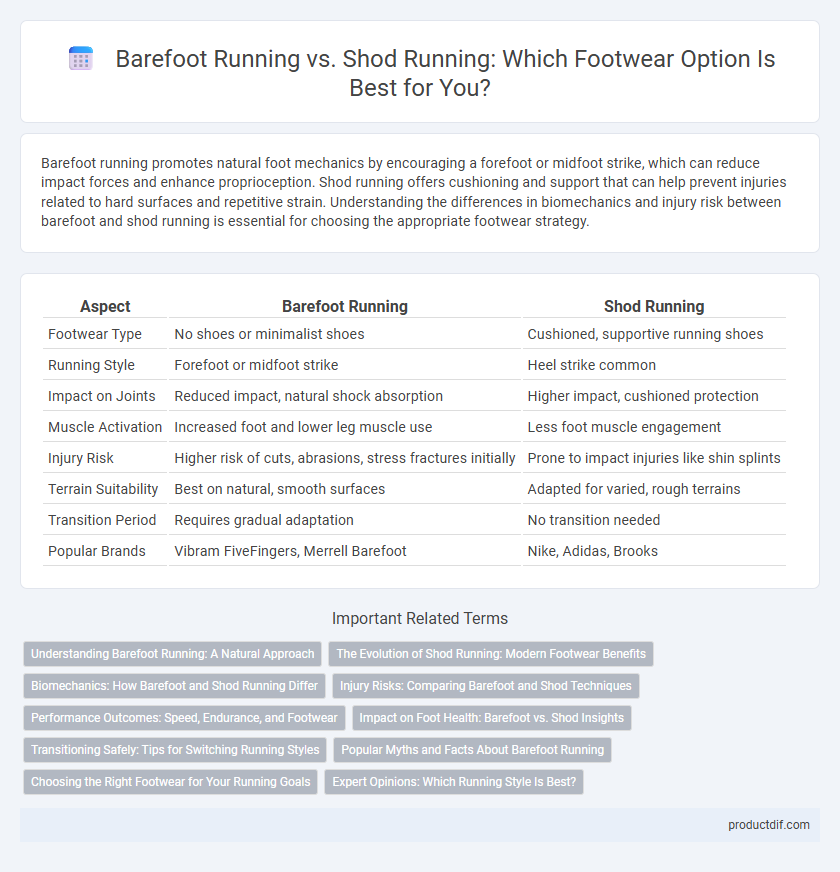Barefoot running promotes natural foot mechanics by encouraging a forefoot or midfoot strike, which can reduce impact forces and enhance proprioception. Shod running offers cushioning and support that can help prevent injuries related to hard surfaces and repetitive strain. Understanding the differences in biomechanics and injury risk between barefoot and shod running is essential for choosing the appropriate footwear strategy.
Table of Comparison
| Aspect | Barefoot Running | Shod Running |
|---|---|---|
| Footwear Type | No shoes or minimalist shoes | Cushioned, supportive running shoes |
| Running Style | Forefoot or midfoot strike | Heel strike common |
| Impact on Joints | Reduced impact, natural shock absorption | Higher impact, cushioned protection |
| Muscle Activation | Increased foot and lower leg muscle use | Less foot muscle engagement |
| Injury Risk | Higher risk of cuts, abrasions, stress fractures initially | Prone to impact injuries like shin splints |
| Terrain Suitability | Best on natural, smooth surfaces | Adapted for varied, rough terrains |
| Transition Period | Requires gradual adaptation | No transition needed |
| Popular Brands | Vibram FiveFingers, Merrell Barefoot | Nike, Adidas, Brooks |
Understanding Barefoot Running: A Natural Approach
Barefoot running promotes a natural foot strike pattern, typically encouraging midfoot or forefoot landings that reduce impact forces and enhance proprioception. Studies show barefoot runners experience lower rates of some injuries compared to shod runners, as the absence of cushioning alters biomechanics and muscle activation. Embracing barefoot running can improve foot strength, balance, and agility by allowing the foot to move unrestricted and engage its intrinsic muscles more effectively.
The Evolution of Shod Running: Modern Footwear Benefits
Modern shod running shoes incorporate advanced cushioning technology and ergonomic designs that enhance comfort and reduce impact-related injuries. Engineered with responsive midsoles and durable outsoles, these shoes improve running efficiency and stability on varied terrains. Innovations such as breathable fabrics and motion control features support foot health and optimize performance during long-distance runs.
Biomechanics: How Barefoot and Shod Running Differ
Barefoot running promotes a forefoot or midfoot strike pattern, reducing impact forces on the heel and encouraging a more natural gait cycle. Shod running typically results in a rearfoot strike due to cushioned heels, which can increase braking forces and joint loading. These biomechanical differences influence muscle activation, proprioception, and overall running efficiency.
Injury Risks: Comparing Barefoot and Shod Techniques
Barefoot running reduces the risk of certain injuries like plantar fasciitis and Achilles tendinitis by encouraging a midfoot or forefoot strike, which lessens impact forces on the joints. Shod running, while offering better protection against external hazards such as sharp objects and uneven surfaces, can contribute to higher rates of repetitive stress injuries like shin splints due to heel striking. Understanding these injury patterns is essential for selecting the appropriate running technique based on individual biomechanics and injury history.
Performance Outcomes: Speed, Endurance, and Footwear
Barefoot running often enhances proprioception and natural foot mechanics, potentially improving balance and stride efficiency for short-distance speed but may increase fatigue over long distances due to less cushioning. Shod running provides cushioning and support that can enhance endurance by reducing impact stress and fatigue during prolonged activities, often resulting in faster times for long-distance events. The choice of footwear significantly influences biomechanics, with barefoot running promoting minimalist movement patterns and shod running enabling greater shock absorption and stability.
Impact on Foot Health: Barefoot vs. Shod Insights
Barefoot running encourages a natural gait and strengthens foot muscles by promoting forefoot or midfoot strikes, reducing impact forces on joints. Shod running, with cushioned shoes, often leads to heel striking, increasing impact loading and potentially contributing to overuse injuries. Studies show barefoot runners experience lower rates of plantar fasciitis and Achilles tendonitis compared to those who consistently run with traditional shoes.
Transitioning Safely: Tips for Switching Running Styles
Transitioning safely from shod running to barefoot running requires gradual adaptation to reduce injury risk and strengthen foot muscles. Start by incorporating barefoot runs on soft surfaces for short distances, progressively increasing duration and intensity to allow the feet and calves to adapt. Pay close attention to proper form and soreness signals, and consider consulting a running coach or podiatrist for personalized guidance.
Popular Myths and Facts About Barefoot Running
Barefoot running is often believed to reduce injury risk and improve foot strength, but scientific studies show mixed results, with some runners experiencing more injuries due to lack of cushioning and support. Shod running provides enhanced shock absorption and protection, which can prevent common impact injuries, yet may also promote unnatural gait mechanics. Understanding the biomechanical differences and individual running styles is crucial to choosing the appropriate footwear for optimal performance and injury prevention.
Choosing the Right Footwear for Your Running Goals
Selecting the right footwear depends on your running goals and biomechanics; barefoot running shoes promote a natural gait and strengthen foot muscles, while traditional shod shoes offer cushioning and support to reduce impact. Runners seeking injury prevention and enhanced proprioception may benefit from minimalist designs, whereas those prioritizing comfort and shock absorption often prefer cushioned, structured footwear. Evaluating terrain, stride, and personal comfort is essential for optimizing performance and minimizing injury risk in either barefoot or shod running styles.
Expert Opinions: Which Running Style Is Best?
Experts in sports medicine and biomechanics offer varied perspectives on barefoot versus shod running, emphasizing individual biomechanics and injury history. Research indicates barefoot running may enhance foot muscle strength and promote a natural gait, while shod running provides cushioning and stability beneficial for impact protection and injury prevention. The consensus recommends personalized assessment to determine the optimal running style, considering factors like foot structure, terrain, and training goals.
Barefoot running vs Shod running Infographic

 productdif.com
productdif.com